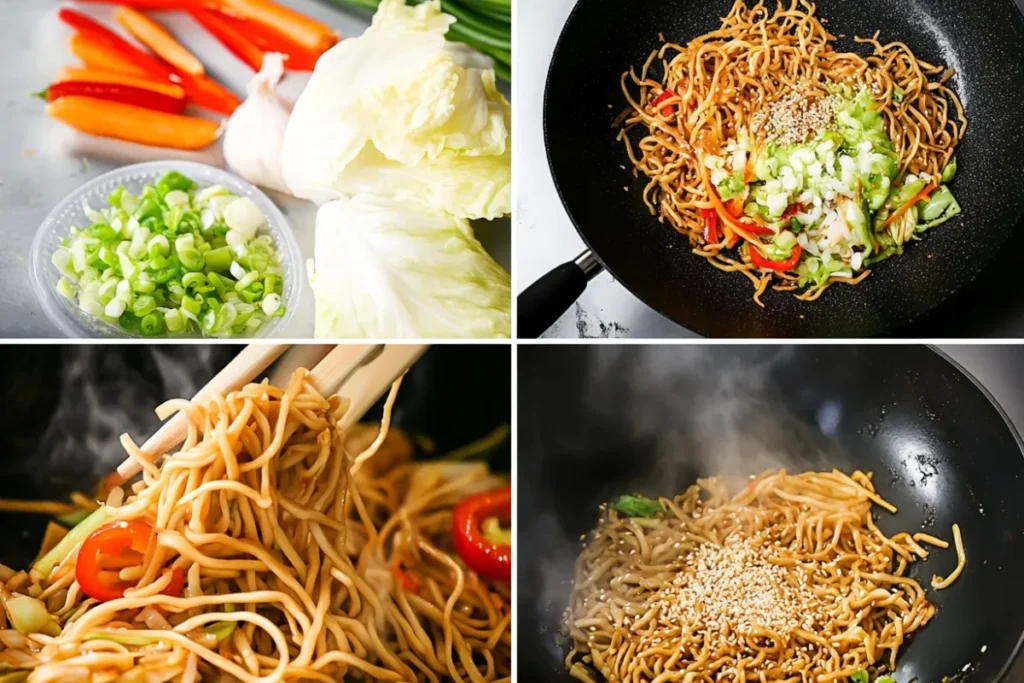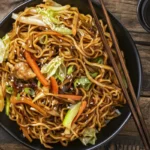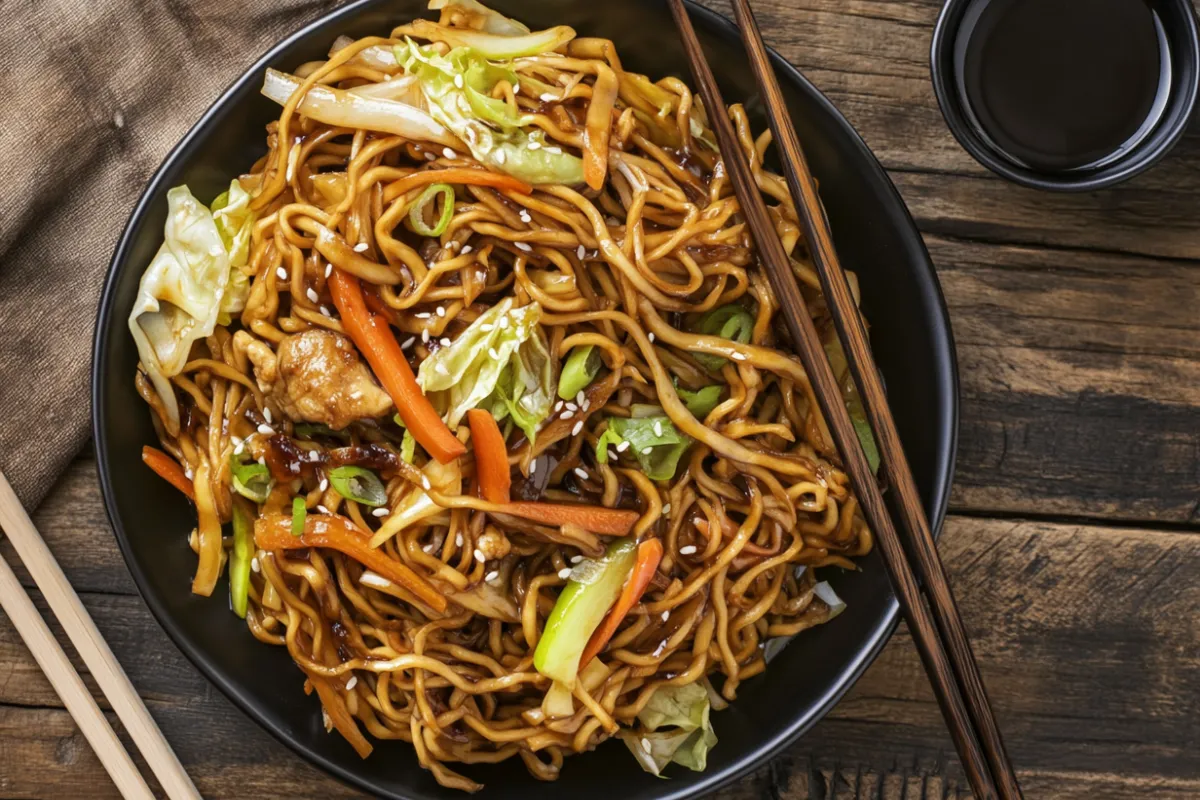Introduction
Yakisoba is a beloved Japanese stir-fried noodle dish known for its savory flavors, versatility, and satisfying texture. But have you ever wondered, what type of noodles are used in Yakisoba? Choosing the right noodles is crucial to capturing the authentic taste and texture of this popular dish. This guide explores the different types of noodles used in Yakisoba, their unique characteristics, and tips for selecting the best noodles to elevate your next meal.
What is Yakisoba? An Introduction to Japanese Stir-Fried Noodles
Yakisoba, which translates to “fried noodles,” is a popular Japanese stir-fry dish that combines wheat-based noodles with vegetables, proteins, and a tangy, savory sauce. This dish is a staple in Japanese street food and home kitchens, offering a versatile and adaptable meal option. For a more detailed look into Yakisoba’s history and traditional preparation, check out this guide on Yakisoba (Japanese Stir-Fried Noodles) – Just One Cookbook.
Yakisoba’s origins trace back to Chinese chow mein, and it was introduced to Japan in the early 20th century. Over time, it evolved to suit Japanese tastes, incorporating locally available ingredients and seasonings. Today, Yakisoba is not only a popular street food but also a comfort dish made in homes across Japan.
Key Ingredients of Yakisoba
To create an authentic Yakisoba, several key ingredients come together to form its signature taste:
- Yakisoba noodles: The primary component, typically made from wheat flour, water, and an alkaline solution that gives them their unique texture.
- Vegetables: Common additions include cabbage, carrots, onions, and bell peppers, providing a crunchy contrast to the noodles.
- Proteins: Options like chicken, beef, tofu, or seafood add a hearty element to the dish.
- Yakisoba sauce: A tangy, slightly sweet blend of soy sauce, Worcestershire sauce, and other seasonings that ties the dish together.
In addition to these core ingredients, Yakisoba often features a variety of garnishes that add visual appeal and extra layers of flavor. These include aonori (seaweed flakes), benishoga (pickled ginger), and katsuobushi (dried bonito flakes), which give the dish its final flourish.
What Type of Noodles Are Used in Yakisoba?
The primary answer to what type of noodles are used in Yakisoba is wheat-based noodles, specifically designed for stir-frying. Understanding what type of noodles are used in Yakisoba is essential for making this dish truly authentic. The most common noodles are wheat-based, known for their chewy texture and ability to absorb the savory Yakisoba sauce. These noodles are different from other Japanese varieties like ramen or udon, specifically designed to hold up well in stir-frying without becoming too soft or mushy. Knowing what type of noodles are used in Yakisoba can help you select the right option, whether you’re aiming for a traditional flavor or experimenting with alternatives like soba or ramen noodles to put your own twist on this classic dish.
The noodles used in Yakisoba differ from other Japanese noodles, such as soba (buckwheat noodles) or udon (thick wheat noodles). While soba noodles have a firmer texture and a distinct nutty flavor, and udon noodles are thick and chewy, Yakisoba noodles are thinner and have a balanced firmness that stands up well to stir-frying.
Characteristics of Yakisoba Noodles
Yakisoba noodles have distinct features that make them ideal for this dish:
- Chewy texture: The chewiness is achieved through the use of kansui, an alkaline water that gives the noodles their firm bite.
- Pale yellow color: Unlike the dark hues of soba or whole wheat noodles, Yakisoba noodles are pale, reflecting their light, wheaty flavor.
- Slightly alkaline taste: The alkaline component of the noodles adds a subtle, earthy taste that balances the tanginess of Yakisoba sauce.
Wheat-Based Noodles: The Traditional Choice
Wheat-based Yakisoba noodles are the classic choice for this dish, known for their chewy texture and ability to hold up well in stir-frying. Here’s a closer look at these noodles:
| Type of Wheat-Based Yakisoba Noodles | Description |
|---|---|
| Steamed Noodles | Pre-cooked and ready to stir-fry, convenient and quick. |
| Fresh Noodles | Soft and chewy, requiring only a quick rinse before use. |
| Dried Noodles | Need to be boiled before use, offering a firmer texture. |
Steamed noodles are the most common form of Yakisoba noodles available in supermarkets. They come pre-cooked, making them extremely convenient for quick meals. Simply rinse them under warm water to separate the strands before tossing them into the stir-fry. Fresh noodles, on the other hand, are usually found in the refrigerated section and offer a slightly softer bite. They require minimal preparation and are ideal for those who prefer a more tender noodle. Dried noodles are less common but are perfect for those who like to keep a pantry stocked with long-lasting ingredients.
Other Noodle Variants Used in Yakisoba
While traditional wheat-based noodles are most common, there are alternative noodles you can use to put a unique twist on your Yakisoba:
- Soba noodles: Made from buckwheat flour, soba noodles provide a nuttier flavor and a firmer texture. Although not traditional, they are sometimes used as a healthier alternative.
- Ramen noodles: These noodles can serve as a convenient substitute, offering a similar texture but with a slightly different, richer flavor profile.
- Udon noodles: Thick and chewy, udon noodles add a hearty bite to Yakisoba, though their size can change the dish’s texture balance.
Each of these alternatives brings its own unique qualities to the dish:
- Soba noodles: Soba is a nutritious option, high in protein and fiber. It’s also gluten-free if made entirely from buckwheat, making it a suitable choice for those with gluten sensitivities. The robust flavor of soba pairs well with strong, earthy vegetables like mushrooms or robust sauces.
- Ramen noodles: Ramen noodles are more elastic and have a springy texture due to the addition of eggs or more alkaline water. They soak up the sauce beautifully, making the dish richer and more flavorful.
- Udon noodles: Udon noodles, while not traditional for Yakisoba, create a heartier dish. Their thick and chewy nature makes them ideal for holding up against heavier ingredients like thick cuts of vegetables or tofu.
Homemade vs. Store-Bought Yakisoba Noodles
Deciding between homemade and store-bought Yakisoba noodles can significantly influence the dish’s outcome:
- Homemade noodles: Making noodles at home allows for complete control over ingredients, ideal for those with dietary restrictions or a preference for fresh flavors.
- Store-bought noodles: Readily available in Asian grocery stores, these noodles are convenient and deliver consistent quality. Look for noodles specifically labeled as Yakisoba to ensure you get the right texture.
Homemade Yakisoba Noodles:
Making your own Yakisoba noodles at home can be a rewarding experience, especially if you enjoy crafting dishes from scratch. By making noodles at home, you can experiment with different flours, such as whole wheat or even gluten-free options like rice flour, to create noodles that suit your dietary needs. Homemade noodles also allow for adjustments in texture; you can make them chewier or softer depending on your preference. While making noodles from scratch requires time and effort, the result is a fresh, flavorful base that can elevate your Yakisoba to the next level.
Store-Bought Yakisoba Noodles:
For those short on time, store-bought noodles are a fantastic option. They are convenient, often coming pre-cooked and ready to use. When choosing store-bought noodles, it’s essential to select a brand that is specifically labeled for Yakisoba. These noodles are designed to hold up under the high heat of stir-frying without becoming mushy. They also have the right balance of chewiness and elasticity, making them a reliable choice for an authentic Yakisoba experience.
Gluten-Free and Vegan Noodle Options for Yakisoba
For those following gluten-free or vegan diets, several alternative noodles can be used in Yakisoba without compromising on flavor or texture:
- Rice noodles: A popular gluten-free option, rice noodles are light and absorb sauces well, though they lack the chewiness of traditional Yakisoba noodles.
- Zucchini noodles (Zoodles): A fresh and low-carb alternative, zoodles provide a crunchy texture and are perfect for a lighter version of Yakisoba.
- Shirataki noodles: Made from konjac yam, these translucent, low-calorie noodles offer a unique, slightly rubbery texture that works well in stir-fries.
Each of these alternatives has its own set of benefits:
- Rice Noodles: Rice noodles are a staple in many Asian cuisines and are naturally gluten-free. They have a delicate texture and are excellent at soaking up the flavors of the sauce. While they don’t have the chewiness of wheat-based noodles, they offer a lighter option for those looking to cut down on gluten.
- Zucchini Noodles (Zoodles): Zoodles are an excellent low-carb, gluten-free alternative to traditional noodles. They add a fresh, crisp element to Yakisoba, making it feel lighter and more vegetable-forward. They are perfect for those looking to increase their vegetable intake or reduce their calorie consumption.
- Shirataki Noodles: Often referred to as “miracle noodles,” shirataki noodles are low in calories and carbs, making them a popular choice for those on keto or low-carb diets. Their unique texture might take some getting used to, but they are excellent at absorbing sauces and adding bulk to the dish without the calories.

How to Choose the Right Noodles for Your Yakisoba
Selecting the right noodles can enhance the overall Yakisoba experience. Here are some factors to consider:
- For an authentic taste: Stick with traditional wheat-based Yakisoba noodles for the classic flavor and texture.
- For a healthier version: Opt for buckwheat or rice noodles to create a lighter dish.
- For a fusion twist: Experiment with ramen or udon noodles to add a creative touch to your Yakisoba.
When choosing noodles, consider the overall texture and flavor you want to achieve. For a classic Yakisoba, stick with steamed or fresh wheat-based noodles that are specifically labeled for stir-frying. If you’re feeling adventurous, don’t hesitate to try alternatives like soba or ramen noodles for a unique spin on the traditional dish.
Cooking Techniques for Yakisoba Noodles
Mastering the cooking techniques for Yakisoba noodles is key to achieving the best results:
- Rinse fresh noodles: Rinse fresh or steamed noodles under warm water to separate them and remove excess starch before stir-frying.
- Stir-fry over high heat: Using high heat ensures the noodles stay firm and develop a slightly crispy exterior.
- Add noodles at the right time: Introduce the noodles towards the end of the stir-frying process to prevent them from overcooking and becoming mushy.
Cooking Tips:
- Use a Wok or Large Skillet: To achieve the best stir-fry results, use a wok or a large skillet that can handle high heat and allow for constant movement of ingredients.
- Avoid Overcrowding: Stir-fry in batches if necessary to ensure all the ingredients cook evenly and retain their desired textures.
- Season Properly: Be sure to season the noodles well with Yakisoba sauce, ensuring they are coated evenly for maximum flavor.
Serving Suggestions and Presentation Tips
Presentation is just as important as flavor when serving Yakisoba. Here are some tips to make your dish visually appealing:
- Garnish generously: Add green onions, sesame seeds, and pickled ginger to enhance the dish’s appearance and flavor.
- Pair with fresh sides: Complement your Yakisoba with a light salad or steamed vegetables for a balanced meal.
- Use a sizzling plate: Serving Yakisoba on a sizzling plate not only keeps the dish warm but also adds an extra layer of excitement to the dining experience.
Popular Variations of Yakisoba Using Different Noodles
Yakisoba’s versatility allows for numerous variations, making it easy to adapt to different tastes:
- Regional variations: Across Japan, Yakisoba takes on various forms, often incorporating local ingredients and noodles that reflect the area’s culinary style.
- Fusion Yakisoba: Mix it up by adding international ingredients or trying out noodles like spaghetti for a Western twist on this Japanese classic.
Regional Yakisoba Variations:
- Hiroshima Yakisoba: Known for its inclusion of oysters and a thicker, sweeter sauce, reflecting the local cuisine.
- Tokyo-style Yakisoba: Typically lighter and more straightforward, focusing on the balance of noodles and sauce with minimal extras.
- Okinawa Yakisoba: Often uses thicker noodles similar to udon, with a distinctly local twist using ingredients like Spam or bitter melon.
FAQs About Yakisoba Noodles
1. What kind of noodles are used in traditional Yakisoba?
Traditional Yakisoba uses wheat-based noodles, specifically crafted for stir-frying.
2. Can you use ramen noodles for Yakisoba?
Yes, ramen noodles can be a good substitute, though they bring a slightly different flavor.
3. Are Yakisoba noodles the same as soba noodles?
No, soba noodles are made from buckwheat and differ in texture and taste from Yakisoba noodles.
4. What is the best brand of Yakisoba noodles to buy?
Look for brands that specify “Yakisoba” on the packaging to ensure you get the right texture.
5. Can Yakisoba be made gluten-free?
Yes, gluten-free options like rice noodles or shirataki noodles can be used.
Conclusion
Knowing what type of noodles are used in Yakisoba is essential to creating an authentic and delicious dish. Whether you stick with traditional wheat-based noodles, opt for gluten-free alternatives, or experiment with different types, the noodles you choose will define your Yakisoba experience. By understanding your options and mastering the cooking techniques, you can make restaurant-quality Yakisoba right at home. So grab your favorite noodles, fire up the wok, and enjoy the rich flavors of this Japanese classic!
Print
Authentic Yakisoba – Japanese Stir-Fried Noodles
- Total Time: 25 minutes
- Yield: 4 servings
- Diet: Vegetarian (if using tofu and no meat)
Description
A guide to making authentic Yakisoba with the right noodles, showcasing key ingredients and cooking techniques.
Ingredients
- Yakisoba noodles (fresh, steamed, or dried)
- Cabbage, shredded
- Carrots, julienned
- Onions, sliced
- Bell peppers, sliced
- Protein (chicken, beef, tofu, or seafood)
- Yakisoba sauce
- Aonori (seaweed flakes)
- Benishoga (pickled ginger)
- Katsuobushi (dried bonito flakes)
Instructions
- Prepare your vegetables and protein by cutting them into bite-sized pieces.
- Rinse fresh or steamed Yakisoba noodles under warm water to separate them.
- Heat a wok or large skillet over high heat and add oil.
- Add the protein to the pan and cook until browned.
- Stir in the vegetables and sauté until tender-crisp.
- Add the noodles and pour in the Yakisoba sauce, tossing everything together.
- Cook for an additional 2-3 minutes, ensuring the noodles are hot.
- Serve garnished with aonori, benishoga, and katsuobushi on top.
Notes
For a gluten-free option, substitute with rice noodles or shirataki noodles. Adjust the sauce to taste for sweetness and tanginess.
- Prep Time: 15 minutes
- Cook Time: 10 minutes
- Category: Noodle Dish
- Method: Stir-frying
- Cuisine: Japanese
Nutrition
- Serving Size: 1 serving
- Calories: 400
- Sugar: 6g
- Sodium: 800mg
- Fat: 15g
- Saturated Fat: 3g
- Unsaturated Fat: 10g
- Trans Fat: 0g
- Carbohydrates: 50g
- Fiber: 4g
- Protein: 20g
- Cholesterol: 40mg
Keywords: Yakisoba, Japanese noodles, stir-fried noodles, Asian cuisine, street food


I truly appreciate your technique of writing a blog. I added it to my bookmark site list and will